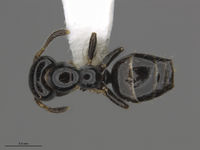Myrmelachista gagates
| Myrmelachista gagates | |
|---|---|

| |
| Scientific classification | |
| Kingdom: | Animalia |
| Phylum: | Arthropoda |
| Class: | Insecta |
| Order: | Hymenoptera |
| Family: | Formicidae |
| Subfamily: | Formicinae |
| Tribe: | Myrmelachistini |
| Genus: | Myrmelachista |
| Species: | M. gagates |
| Binomial name | |
| Myrmelachista gagates Wheeler, W.M., 1936 | |
A Hispaniola endemic described from a single worker collected in La Visite, Haiti in 1934. A second worker was collected from litter in a deciduous transitional forest, at 1190 m at Los Arroyos, Dominican Republic in 2014. The location is adjacent to the Haitian border and ~ 60 km from the type locality.
Identification
Similar to the Cuban species Myrmelachista rogeri. The only Formicinae with nine antennal segments are Brachymyrmex and Myrmelachista. The latter has a three segmented antennal club. There are two species of this genus known from Hispaniola, gagates and Myrmelachista ramulorum; gagates is distinctive in its smooth jet black body and rectangular shaped head.
See Longino's comments regarding Caribbean Myrmelachista.
Distribution
Latitudinal Distribution Pattern
Latitudinal Range: 18.84354° to 18.22711°.
| North Temperate |
North Subtropical |
Tropical | South Subtropical |
South Temperate |
- Source: AntMaps
Distribution based on Regional Taxon Lists
Neotropical Region: Dominican Republic, Greater Antilles, Haiti (type locality).
Distribution based on AntMaps
Distribution based on AntWeb specimens
Check data from AntWeb
Countries Occupied
| Number of countries occupied by this species based on AntWiki Regional Taxon Lists. In general, fewer countries occupied indicates a narrower range, while more countries indicates a more widespread species. |

|
Estimated Abundance
| Relative abundance based on number of AntMaps records per species (this species within the purple bar). Fewer records (to the left) indicates a less abundant/encountered species while more records (to the right) indicates more abundant/encountered species. |

|
Biology
Castes
Nomenclature
The following information is derived from Barry Bolton's Online Catalogue of the Ants of the World.
- gagates. Myrmelachista gagates Wheeler, W.M. 1936b: 204 (w.) HAITI.
Unless otherwise noted the text for the remainder of this section is reported from the publication that includes the original description.
Description
Worker
Length 1.7 mm.
Very similar to Myrmelachista rogeri Ern. Andre of Cuba, but differing in the shape of the head, thorax and petiole, in color and pilosity. Head larger and more sharply rectangular, less narrowed in front, where it is as broad as behind. Eyes larger. Promesonotum longer and somewhat less convex above, epinotum proportionally longer and broader. Petiolar scale decidedly thicker, with convex anterior surface and very sharp superior border, which is more deeply and more angularly excised than in rogeri.
Very smooth and shining, like rogeri, with similar pilosity, but the hairs on the gaster less numerous and longer. Jet black; antennae and mandibles dark brown, scapes darker and more blackish, their tips and the basal funicular joints yellowish brown; femora black; tibiae very dark brown, paler at their bases and tips; tarsi and tibial spurs brownish yellow; last tarsal joint of each leg blackish.
Type Locality Information
Described from a single specimen taken by Dr. Darlington at La Visite, 6000-7000 ft., Haiti.
References
- Longino, J.T. 2006. A taxonomic review of the genus Myrmelachista in Costa Rica. Zootaxa. 1141:1-54.
- Lubertazzi, D. 2019. The ants of Hispaniola. Bulletin of the Museum of Comparative Zoology, 162(2), 59-210 (doi:10.3099/mcz-43.1).
- Wheeler, W. M. 1936c. Ants from Hispaniola and Mona Island. Bulletin of the Museum of Comparative Zoology 80: 195-211 (page 204, worker described)
References based on Global Ant Biodiversity Informatics
- Kempf, W.W. 1972. Catalago abreviado das formigas da regiao Neotropical (Hym. Formicidae) Studia Entomologica 15(1-4).
- Longino J. T. 2006. A taxonomic review of the genus Myrmelachista (hymenoptera: Formicidae) in Costa Rica. Zootaxa 1141: 1-54
- Perez-Gelabert D. E. 2008. Arthropods of Hispaniola (Dominican Republic and Haiti): A checklist and bibliography. Zootaxa 1831:1-530.
- Wheeler, William Morton. 1936. Ants From Hispaniola and Mona Island. Bulletin: Museum of Comparative Zoology at Harvard College. 80(2):192-211.

